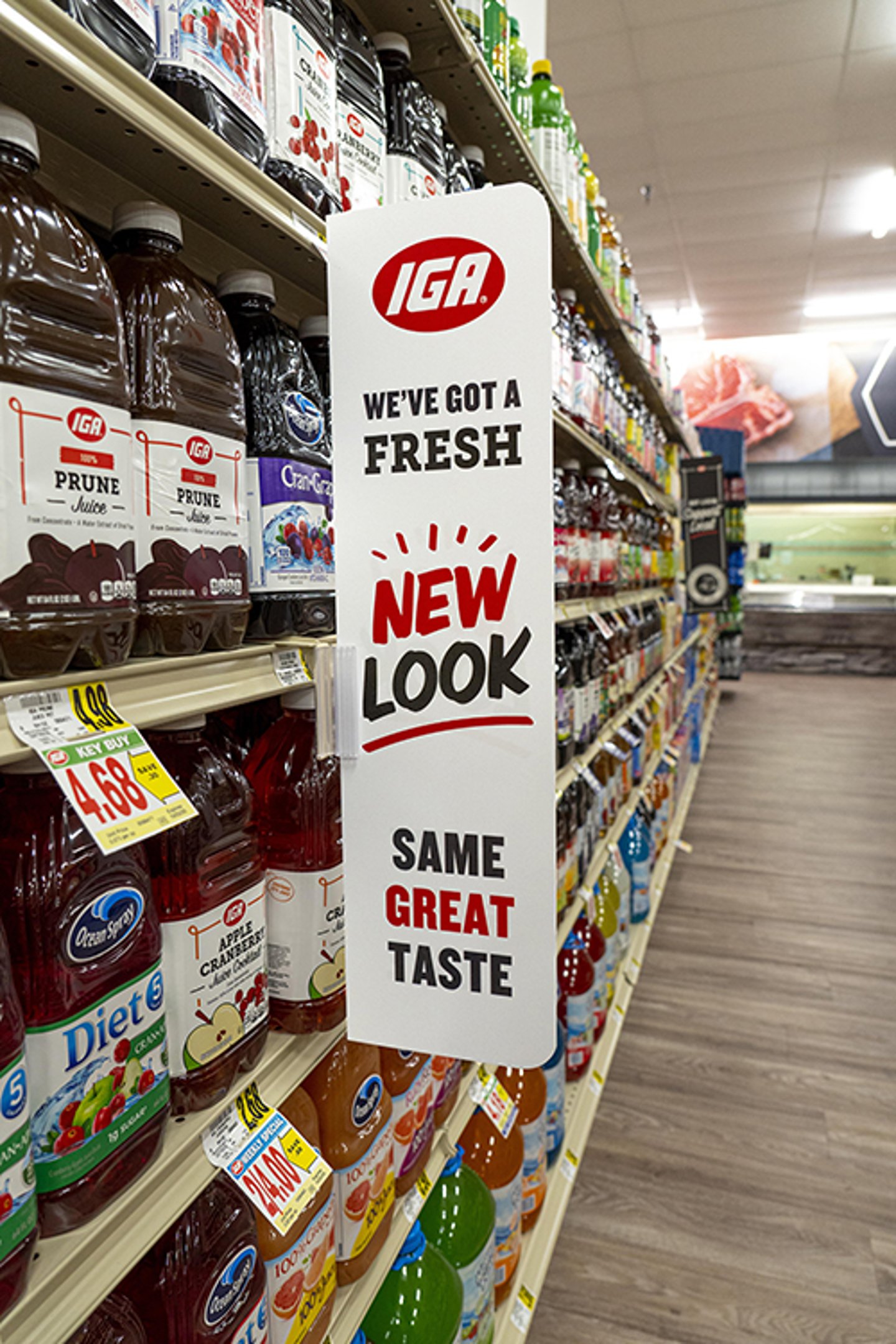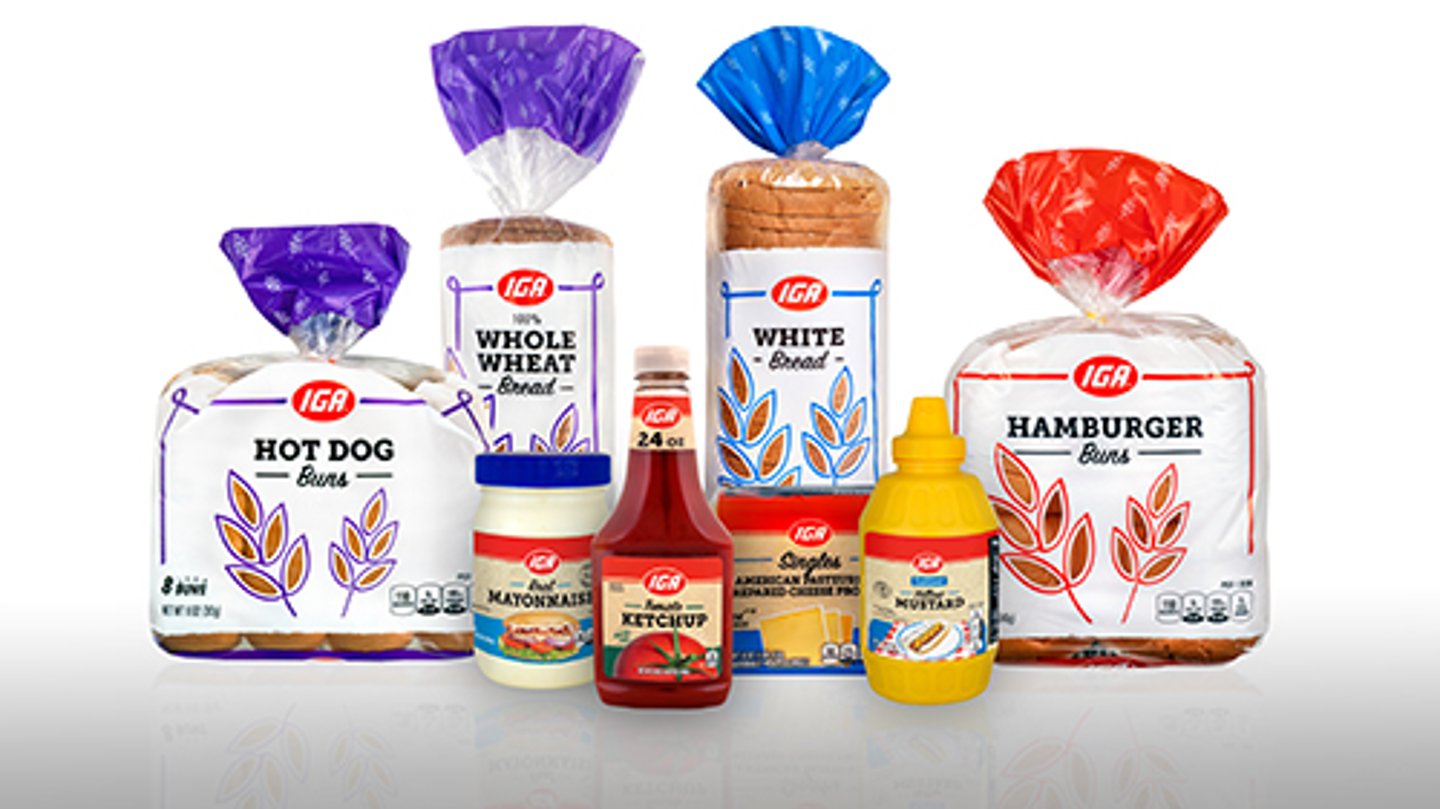Profile: IGA’s store brand refresh
It has been more than 10 years since the Independent Grocers Alliance updated its store brand look, but in September the grocery trade association — which represents thousands of independent retailers globally — kicked off a modern redesign, backed by a massive visual merchandising program and digital marketing effort.
The September launch saw roughly half of its 1,200 redesigned IGA Exclusive Brand products hit shelves while the other half will roll out over the months ahead. The redesign also anchors the store brand for new line extensions like a possible plant-based line that could launch in the next two years.
IGA Global’s brand overhaul began with two key hires: Robin Groscurth, director of exclusive brands, joined the Chicago-based association roughly 18 months ago, after launching Fresh Thyme’s first-ever private label program. Two years earlier, IGA Global named John Ross its CEO, who came from several years with Inmar and before that Shopper Sciences, a data company and retail media agency, respectively. He also had retail experience at Home Depot and hard goods stores.
With that combined experience, it’s no surprise that the reintroduction of the IGA Exclusive Brand would land with such style and a comprehensive hyper-local marketing program — both in-store and digitally.
“We relaunched the brand under a new tagline called, ‘Local Equals Fresh,’” said Ross. “Each retailer, they’re independents, which means we are a case study in hyperlocal marketing. That’s the thing that big brands have trouble doing. They want to be more locally engaged, but there’s so much efficiency in having a homogenous assortment that it’s very hard for them to do.”
It’s the opposite for IGA, he said. “If you’ve got an urban store, if you’ve got a store that serves a Hispanic community or an African American community or a Polish community, if you go to a store that’s intensely rural or suburban, each of those stores is going to have a unique assortment, and they’re going to market in different ways,” he added.
In total, IGA works with more than 1,200 independent grocery stores in the United States and close to 5,000 in 30 countries around the world. The retailers pick and choose which IGA Exclusive Brand items fit their store and get merchandising materials to promote the items, with an emphasis on items being locally sourced.
The Redesign
Ross said the first red IGA letters began appearing on its own brand of packaging more than 50 years ago, possibly even before the concept of private label was really known. IGA formed in 1926, emerging as a way to battle the Great Atlantic & Pacific Tea company, the dominant national chain at the time. It was a buying cooperative that did futures trading, buying commodity products, and innovated in many ways since those early days. More than 100 years later, it’s still going strong.
Groscurth kept the association’s history in mind when embarking on a full-scale redesign, wanting to create something modern but not shake up any of the built-in trust that the brand had earned over the years. She said she wanted the look to be “cutting edge” that leveraged the brand’s heritage through the signature trademark IGA, a vivid red craft paper color and top-notch photography.
Those are the key elements in the redesign, represented in the assortment the company calls its core program of items. But the packaging can become a bit more playful as it expands out into a custom program for such novelty categories as ice cream, for example, where brand-new characters can be created and added to the packaging. The same goes for specialty line extensions (including plant-based or organic) that could come over the next year or two.
The structure is a new tiered strategy of store brand lines, anchored by the core program look and the IGA logo. “As long as we have our IGA trademark, our label, our logo on there, the consumer is going to gravitate,” Groscurth added.
She also said the thinking behind a tiered approach was to make IGA competitive against national brands and other national brand equivalents. “I said to myself, ‘Hey, there’s no reason that we can’t be better than the rest.’ We have trust, value and quality that our consumers just love us for, and so this gave us the ability to say, ‘in the dairy set, I want to have this modern, clean look against the cottage cheeses of the world,’ and these brand loyal categories, where people continually shop there, I wanted to be better. I want to look cool. I want to be modern,” she said.
Prior to the revamp, IGA studied the brand, using market researchers and its agency of choice, Porchlight, Atlanta. The market research found that, while independents won’t win the lowest-price-possible game, scores on trust and quality were through the roof, Ross said. That included loyalty in the store brand, where just under a third of IGA shoppers were found to be shopping the store because of its private label.
In March, IGA saw a 15% increase in orders for its store brands, compared with a year ago, so there has been a lot of momentum around its store brand program, and it was sorely in need of an update.
The coronavirus pandemic delayed the initial summer launch to begin in September. “The last thing we wanted to do was have retailers have to distract from running 30, 40, 50% comp days to put up new signs and have to do a bunch of stuff,” Ross said. “There was a benefit in that the pandemic stock-up shopping helped sell-through a bunch of old merchandise, making room for the redesigned packages.”
He continued: “But the retailers are tired. It’s been an exhausting year. And with turnover in the stores and now a resurgence of COVID going on in many markets, it’s still hard, but we went ahead and launched, and the feedback from the retailers has been great. They’re really excited to see the product.”
Omnichannel Attack
Helping drum up that excitement is an ongoing, world-class visual merchandising program in stores, and a digital program that includes rich media ads around the store brand items serving 30 million shoppers.
The displays include wobblers, window signage, signage at the registers, ceiling signage, endcap displays, shelf toppers and more, each with its own flair and delivering a message of value and local. Displays will change out quarterly, emphasizing holidays or promoting recipes that the store brands can be used to make.
In fact, one of the nuanced updates to the packaging include on-package recipes. Groscurth said she wanted to educate shoppers on what is inside the package, be more transparent on the label, but also added fun illustrations where possible around the UPC code like the image of bread popping out of a code.
“I want a consumer to walk down the aisle and see our product pop out on the shelf,” she noted. “I don’t want it to blend in with the rest of the brands.”
The packaging works in concert with the displays. Signage showing the new product calls out the store’s “Double Money Back Guarantee,” “Quality Without Compromise,” and “Trusted by IGA Families for more than 100 years,” and more. There are category-specific displays too, all part of an entire system that the independent retailers can select and put up.
Digitally, the group is working with influencers to post about the new look and more, and rich media ads are being integrated into its digital circular that goes out to 30 million shoppers. The digital ad just launched a few years ago and has eyes on 50 million users.
The ad is delivered to a shopper based on their zip code, so each ad is tailored to that community delivering local media. National ads are also mixed in with offers for local stores and run alongside store brand offers but in deeply engaging video ads like syrup swirling over fluffy IGA brand pancakes.
Themed ads in the digital ad also sync up with in-store themed signage, and QR codes can be scanned in stores to unlock recipes, and more. The promotional schedule, for example, includes November materials celebrating “Family Meals Made Easy” with a recipe-based sweepstakes, and influencers promoting the contest.
Themed promotions and merchandising around the store brand redesign also run alongside merchandising elements that scream IGA’s local sourcing and remind shoppers that the stores are sourcing from local farmers.
“I’m so proud of the progress we’re making, of harnessing the idea of local in a bigger and bolder way,” Ross said. “Our private label is a combination of things we buy and things we make, and we are arming the retailer with the same tools that a national brand would have, that they can deploy on products that create or bake or cook inside their store.”
The history of independent grocers is a humble culture, Ross said.
“We’re not used to running around beating our chests and saying all these great things that we do, the fact that we bake fresh every morning or make our own doughnuts or grind our own sausage,” he said. “We don’t tell our own story. And yet when you do tell your story, when you tell people that the fruit wasn’t cut in a factory four days ago, but it was cut fresh this morning, sales go up. And it is just amazing how much what we actually do is exactly what shoppers want.”
Constant Communication
As the revamped store brand continues to launch to its independent retailers and explore expansion, the IGA Global team must be in constant communication with the retailers, wholesalers and suppliers.
Just as with the redesign, Groscurth presented it to leadership, then to wholesalers, as well as a national advisory board, all sharing feedback and insights on what hurdles they are facing in the industry and where they see opportunities.
IGA prides itself on having multiple product suppliers across categories, too, something that did help during the pandemic when it was a challenge keeping product in stock, but also requires constant communication.
“When I came on board, the goal was communication, communication, communication — what we’re doing, when we’re doing it, and the expectations that we have from suppliers during this transition,” she said.
Groscurth held quarterly meetings with suppliers, sharing what categories were being redesigned and products being worked on so nothing felt like it was coming out of left field to them. Of course, the pandemic has shifted things as well, streamlining efficiencies in some categories to focus on seven SKUs rather than 17, for example, to maintain supply and demand and that’s impacted suppliers. The lack of trade events has also impacted Groscurth’s ability to meet and innovate with new suppliers, but she’s always looking for strategic relationships with suppliers.
“I want to work with suppliers that think of us first, that want to come to the table with innovation. They want to come to the table with change and how to do things better… and where they see our brand, our categories growing in the next five years,” she said.
Ross added that the reality is there are less independent private label brands today, and IGA is fortunate to be one of the strongest. “But we suffer that same pressure,” he said. “The only thing that we can do is to ensure that we’ve got a great consumer experience, best-in-class packaging, and we invest in marketing to drive volume behind the brand.”






